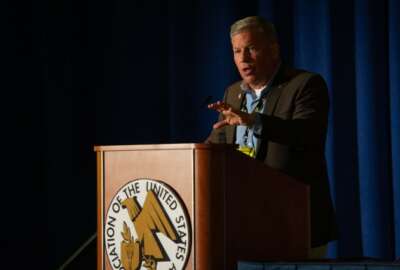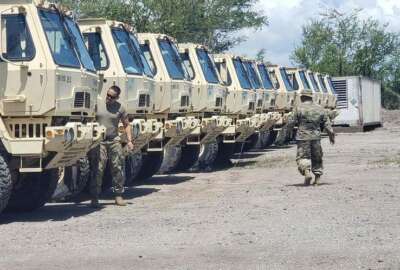
National Guard stays on mission as it adjusts to new world
For the National Guard, as for so many organizations, much is virtual these days -- but the Guard's mission remains real enough.
Best listening experience is on Chrome, Firefox or Safari. Subscribe to Federal Drive’s daily audio interviews on Apple Podcasts or PodcastOne.
For the National Guard, as for so many organizations, much is virtual these days. Like the charitable 5K race it’s sponsoring and its upcoming general conference with all of the armed services chiefs. But the Guard’s mission remains real enough. For an update, Federal Drive with Tom Temin turned to the president of the National Guard Association of the United States, retired Army National Guard Brigadier Gen. J. Roy Robinson.
Interview transcript:
Tom Temin: General Robinson, good to have you on.
Gen. J. Roy Robinson: Tom, how you doing? Thank you so much for having us.
Tom Temin: First, let’s talk about some of the topical things. You’ve got a 5k race, the ending is just about to happen. Tell us what the benefit is and how many people you’ve had so far.
Gen. J. Roy Robinson: So we’ve got well over 300, we’ve got I think, 48 out of 50 states represented. You know, we do a 5k run every year at our annual conference, which we have somewhere across the 54 states, territories or the District of Columbia. This year, it’s a little different because of the environment. We’re having a virtual conference. Which will actually be a live stream conference is what we’re doing. And as a part of that, we’re going to have a virtual 5k, and members can sign up. And they can go out and set their own course, so to speak, and time themselves in their run or their walk, whichever they prefer. And then they submit their times, and we’ll publish them on the virtual 5k board that we’re keeping. So it’s an opportunity to kind of make things a little bit normal, as normal as we can make it as we venture into this virtual conference environment.
Tom Temin: Yeah, as a longtime runner myself, I’ve noticed that quite a robust infrastructure has developed in recent months to support the activity of virtual road races.
Gen. J. Roy Robinson: It’s amazing, I got a call, in fact a couple of calls. One was from one of our really senior leaders, his comment was, I gotta say that I may set a world record on this thing.
Tom Temin: Nobody can tell if you’re running downhill I guess to get your distance done.
Gen. J. Roy Robinson: Yeah, it’s a good opportunity. I have to say I didn’t know how this will be received by our membership. We have about 45,000 members. We represent about 450,000 members of the Army National Guard in the Air National Guard, and we advocate on their behalf over on the heels. So I didn’t know how this would be received initially. And I gotta tell you, I’m surprised, pleasurably surprised, by the way that this has been received and the participation that we’ve had.
Tom Temin: About the conference itself, the virtual live stream conference, what are the big topics do you think on the mind of the service leaders as they talk to the National Guard members?
Gen. J. Roy Robinson: I tell ya, it’s really a unique experience. So this is 142nd general conference. We’ve been gathering for that long. When we put on a conference, we normally invite all the senior leaders, actually this conference, we actually have four sitting members of the Joint Chiefs. They’ll come in and they’ll talk about the issues that the Army is facing and kind of the things that we’re trying to work through with the Army National Guard. The senior leader of the Air Force will come in and and talk about the Air Force issues and how they affect the Air National Guard and kind of what the future looks like. We have a brand new chief of the National Guard Bureau who has only been in place it’s General Dan Hokanson, I guess for a little less than a month. So this gives him an opportunity to get up in front of our membership and talk about his path forward with the National Guard Corps. He’s over the Army and the Air. And then we’ll have each of the directors, we have a director that runs the Army National Guard, and we have a director that runs the Air National Guard. And both of those directors are lieutenant generals. So Lieutenant General Mike Lowe and Lieutenant General John Jensen, and they’ll come in this gives them an initial opportunity to kind of lay the groundwork for the vision that they have for each of the two Army National Guard directorate and Air National Guard directorate as they move forward in their leadership role.
Tom Temin: Looking at the bigger issue as National Guard members and Air National Guard members throughout the country deal with their personal lives, their service and training requirements of the National Guard in all of this pandemic, what’s your sense of how they’re coping and what some of the challenges are?
Gen. J. Roy Robinson: I gotta tell you from a guy who spent 33 years in uniform in the Army National Guard down in the state of Mississippi, I am absolutely in awe of the way that the members of the National Guard have been able to respond and continue to respond over the last couple of years. It’s amazing to me, a lot of people are not as familiar with all of the activities that the Guard might take home, but I can tell you on any given day, somewhere across the 54 states, territories or the District of Columbia, you have members of the National Guard who are responding to fires to floods, tornadoes, regional small earthquakes, disasters, some type of civil unrest. If you sit down and like I do occasionally I have a retirement home down in Alabama. And a couple weeks ago, I was watching the evening news that was focused on the Alabama local news. And I guess, maybe three out of the five lead stories on the evening news that evening, involved members of the National Guard responding in some way. And I gotta say, I mean, it’s quite a responsibility that these young men and women have taken on and most don’t realize, I mean, we still have over 20,000 I think it’s about 25,000 soldiers and airmen that are still in Iraq, Afghanistan, Kosovo, Kuwait, and even in the Sinai. The overseas warfighting mission continues. I think at the peak of the COVID-19 response, we had about 50,000 members, just under 50,000 that were on some type of orders throughout the 54 states, and territories and the district that continues. I mean, I suspect that as you know, the President has extended the federal declaration — and I think you’ll see most of those members of the National Guard as they continue to the end of the year, until somebody defines what the end of COVID-19 looks like. They’ll continue to provide the support and the local communities just like they’ve been doing.
Tom Temin: And of course, they have to deal with the danger of the situation that they’re addressing directly, such as civil unrest or some kind of a natural disaster, and overlaid with the fact that they are out there close to people, close to one another in all of this COVID. So do you sense that they’re equipped properly for all of that?
Gen. J. Roy Robinson: A lot of the equipment we continue to upgrade, we continue to try to bring in new equipment. But I’d tell ya, there’s one significant issue that we’ve talked about a lot, and we’re going to continue to talk about it. Based on the status that the soldier airman is in, they may or may not have medical coverage. They have to be on an order that exceeds 30 days to be covered by TRICARE. That’s if they’re in a federal status, if they’re in a state active duty status, which we still have a lot of soldiers and airmen that are, they may or may not be covered by any health insurance unless they bring their own private health insurance with them when they’re mobilized. And if you think about it, over the course of the COVID-19 response, I think the number I read this morning was we’ve had 4,566 members of the National Guard that have tested positive for COVID-19. Fortunately, and thankfully, we’ve only had two deaths. But I have to say, these members of the National Guard have been on the frontlines with doctors and nurses doing the exact same thing that the first responders are doing in constant contact with society and all the risks that go with trying to respond to a pandemic in that way. And I have to say there’s a mechanism. If these soldiers were mobilized and deployed overseas, and they were in a theater of war, and they came home and they were taken off of the mobilization orders, they would have six months of what we call transitional medical coverage. It’s a program called TAMP. I like to think it’s kind of a fluke in the law, kind of an oversight. If they’re mobilized for a period of time within the continental US and they come off of that mobilization, hey don’t qualify for that transitional coverage. So we’re working with the Congress. We have a lot of support in the Congress. And we’re working legislation to change the law to include service within the continental US in the TAMP program. But we’re having soldiers and airmen that are coming off of mobilization orders, almost daily, and they don’t have that six months transition coverage, even though they are the ones have been in constant contact with members of society and exposed obviously to the COVID-19. So we’re working that very hard. I’m hoping that members of Congress are listening. The problem is that it takes time. As you know, Congress doesn’t always move on our schedule. And right now we have soldiers and airmen who have been affected by that oversight because they don’t have the transitional coverage.
Tom Temin: Alright. Well, let’s hope they’re listening this time around because I know you and I have discussed that before. And maybe that’ll come to pass in the next session. Retired Brigadier General Roy Robinson is president of the National Guard Association of the United States. As always, thanks so much for joining me.
Gen. J. Roy Robinson: Tom, thank you so much for having us and thank you for what you do for the members of the National Guard.
Copyright © 2025 Federal News Network. All rights reserved. This website is not intended for users located within the European Economic Area.
Tom Temin is host of the Federal Drive and has been providing insight on federal technology and management issues for more than 30 years.
Follow @tteminWFED






